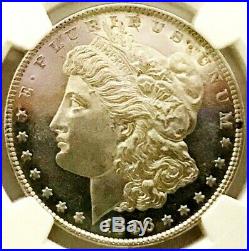
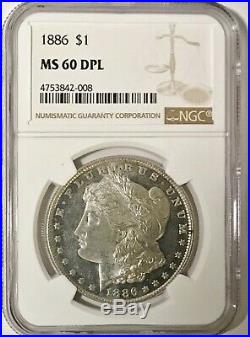
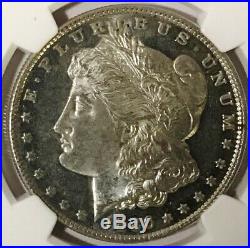
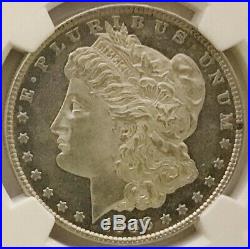
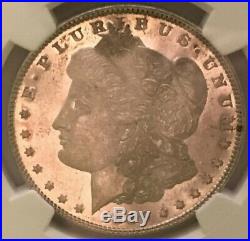
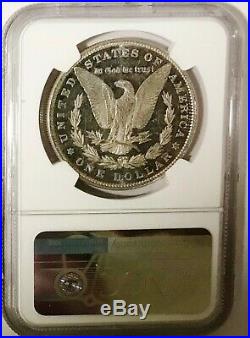
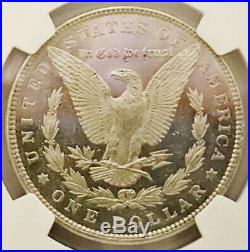
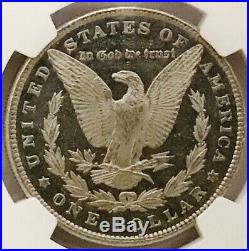
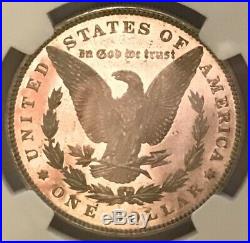

Great feedback check out some of the recent feedback we’ve received from our customers. One of the Best and Honest Sellers! To Do Business With. Time and again, Shenandoah. Arrived early and in great condition. There’s a reason. And thank you to ALL of our customers for allowing us to serve you with quality coins, accurate and honest descriptions and photos, and above-and-beyond service. Your satisfaction will always be our No. An 1886 P Morgan Dollar certified MS 60 DPL by NGC. This DMPL features crystal clear, glass mirrors whose reflectivity reaches well over 20 inches on both sides. It’s also a clear off grade, with eye appeal and strike looking much closer to a 62 or perhaps a 63 more on that below. The cameo is lustrous, but not white or thick. As such, it’s below average and fairly light for a DMPL, but is well-defined and fairly sharp, with decent eye appeal. And actually, in full light it looks average to above-average, with the light really bringing out solid contrast that is not as apparent in shadow. Speaking of which, the fields come very close to being full “black, ” in terms of “black-and-white” contrast, on this coin. Chafe chatter prevents it from getting there, but even so, it’s at the very least a very dark gray, though some would call it black. While a swirl of unbroken chafe chatter is evident on the obverse fields surrounding Liberty, and several runs and contact marks can be seen in full light at an angle, it really doesn’t detract much from overall eye appeal. Looking at the coin straight ahead and under normal lighting, the chafe is visible, but by no means overwhelming, and the rest of the chatter is all but imperceptible. The reverse cameo is much nicer and with the fields offer a more traditional black-and-white contrast. Significant chatter is present, but there’s nothing that really draws the eye or is even all that noticeable from normal viewing distance in hand. Two of the three “digs” below or in the motto are MUCH less dramatic and less deep than the No. 7 photo shows and are essentially unnoticeable in hand. And the third one is actually a cud on the “t” in “trust, ” which gives the staff a flattened appearance through a loupe. As mentioned above, this coin is what I would call an obvious undergrade, and an excellent candidate for re-grade submission. The strike is full and sharp, and the chatter, while prevalent, is not overwhelming at all. Taken together, strike and eye appeal on this coin gives it the look of a 62 or 63. I’m not sure what the NGC grader who judged this coin saw in it that would make it a 60 — he or she may just be the kind of grader that gives a lot more weight to the amount of chatter, as opposed to its type and its affect on eye appeal. Since grading is so subjective, you can never be sure what the third-party-grading companies will do. But it should be a consideration for anyone interested in re-submits. And regardless of its actual grade, the coin itself has the look of a 62 or 63, which for aesthetic collectors is the only thing that really matters. And don’t forget to check out my other listings when you have a moment. Thank you for your continued support of Shenandoah. However, coins must then be re-secured in a new cardboard flip or mylar holder for the return trip. Don’t like your item? Found a better price? Run it through the wash? OK, that would be a problem. But almost anything else that’s right, no problem. Thank you for reading and for looking at our items. Upon its release in 1878, there was little evidence that the Morgan Dollar would be anything but an embarrassing footnote in the world of numismatics. Its design was roundly criticized by most coin connoisseurs and the public alike, and it remained unpopular throughout its production run, which stopped in 1904 before being brought back for a single year in 1921. Despite these humble beginnings, however, the Morgan dollar has grown to become the most popular U. Collectible coin in history. And no version of the Morgan Dollar is as popular as the deep mirror proof-like, or DMPL. With blast-white cameos, sharp black-and-white contrast and deep crystal-clear mirrors, it’s easy to see why DMPLs and, to a lesser extent, the proof-like, or PL, Morgan are the most sought-after in the series. Unfortunately, they are also among the hardest to photograph accurately. A couple of important things to remember right off the bat. Cameos and contrast will almost always look brighter, whiter and sharper in photos whether they’ve been manipulated or not. While this isn’t the case with every DMPL listing, it is, to one degree or another, with the vast majority of them. Most of the time, that’s not the case. The difference between a Morgan’s appearance in photos and in hand is simply a product of the camera’s tendency to exaggerate the DMPL’s defining features, and the fact that most photos are close-ups, which naturally make the coin look three, four or five times bigger than it is. By definition, that will exaggerate everything about it, including its attributes. That makes it a challenge for ethical sellers to take photos that don’t make their coins look much better than they are, while still giving prospective buyers a good look at its best points. It also makes a listing’s description all the more important. They don’t manipulate photos and don’t lie in their descriptions. Many, though not enough in my opinion, will tell you whether the cameo, contrast or mirrors are significantly less impressive than what the photos show. Most sellers aren’t going to detail very slight differences and that’s understandable. In a majority of cases, an out of the way bag mark or imperceptible run that can’t be seen in photos won’t affect eye appeal or the coin’s value. But if there’s something that’s especially noticeable in hand that the photos aren’t showing or if the pictures are significantly exaggerating contrast or cameo thickness, for example that really should be mentioned. The Doctors Are In. So be on the lookout for those as well. The good news is they’re not hard to spot if you know what to look for. Another red flag to watch for are sellers who shoot all of their coins from the same angle and use lighting that always highlights the same part of the coin, usually with Liberty getting the spotlight from a powerful, off-camera light source. The light is usually angled in such a way to make cameos look much whiter and/or brighter than they are. In and of themselves, photos like this aren’t necessarily deceptive. Photos showing a range of lighting and angle options will give you a more comprehensive look at a coin’s various features, good and bad. In short, one photo each of the obverse and reverse that are clearly blasted with light won’t cut it. The same holds true for coins shot only in shadow. Such photos will often hide most, if not all, of a coin’s defects, including bag marks, runs, scratches, hairlines, and uneven tone an indication a coin may have been cleaned. Don’t hesitate to ask for additional photos, specifying that you’d like to see those taken in both light and shadow, preferably at different angles. Remember, you’re the customer. Then you have bait-and-switch (BAS) sellers. The bait-and-switch works like this. Now I know what you’re thinking. How do I know the sale of that pristine coin wasn’t canceled for some reason? Fair points — and sometimes you can’t know for sure. But a little investigation will often confirm the BAS is on. When you get the results, check the photos against those in the active listing. If they’re the same, you may well have a BAS. To confirm it, go through the sellers feedback until you find the review for the coin in question. So now you know the BAS is on and the coin in the photos is not the one the winner will get. Naturally, that information is nowhere to be found in the listing. Super and Super Absurd. Perhaps the easiest red flag to spot is the overhyped listing title. Now there’s nothing wrong with a title or a listing description for that matter that plays up a coin’s attributes. After all, I want to get as many buyers as possible to look at my coins. What I don’t want, however, is to exaggerate to the point of deception. So how do you tell the difference between the eager yet still ethical sellers and those who will say anything, truthful or not, to make a sale? Some sellers in this category may be listing all of their coins with a single title simply out of convenience or to save time. But in many cases — particularly those in listings that also have photos showing impossibly perfect coins — it crosses a line from legitimate time-saver to outright deception. Then there are the sellers that do nothing but string together a bunch of superlatives. If a coin is listed as being a Mega-Monster-Sweet-Turbo. , you might want to think twice. I mean, are we talking about sports cars here or silver dollars? Remember, the overhyped titles often go hand-in-hand with the manipulated photos, but not always. Sometimes you’ll find sellers who take care to describe their coins more or less accurately in the titles and listings, but who post ginned-up photos. A Word About Feedback. Collectibles in general, and coins in particular, are among the categories in which buyers are more reluctant to leave negatives. There are a couple of reasons for this. The quality and value of collectibles are subjective, to say the least, and buyers know that opinions will often vary. They’re reluctant to tag someone with a negative in cases where a return or dispute might have come down to nothing more than an honest disagreement. That comes with the territory. And remember, the opposite is also true. All that said, dishonest sellers might still have some very nice coins among their listings. But don’t be surprised if that silver dollar listing with photos showing a porcelain-like cameo and the patently absurd claim of “30 inch mirrors” turns out to have a very weak cameo and mirrors that are only PL, if that. The bottom line: it’s a crap shoot, at best. You might get a nice coin. But either way, you almost certainly won’t get one that looks anything close to what the photos show and you probably will have overpaid for the coin, no matter how nice it is. Sure, but this is not a sales pitch, I assure you. And I’m certainly not trying to bash the competition for the simple fact that I dont have any. I sell 3 or 4 coins a week as a side business — though calling it a “business” is a stretch. Its mostly an extension of my love for coin collecting, which has been a hobby of mine for as long as I can remember. They don’t affect my business any more than I affect theirs. There are plenty of honest and respectful sellers who deserve your time and business. The item “1886 P Morgan Dollar NGC MS60DPL, DMPL, Lite Cameo But 23 Mirrors Undergraded” is in sale since Tuesday, November 19, 2019. This item is in the category “Coins & Paper Money\Coins\ US\Dollars\Morgan (1878-1921)”. The seller is “shenandoah.blue” and is located in Staunton, Virginia. This item can be shipped worldwide.
- Modified Item: No
- Country/Region of Manufacture: United States
- Certification: NGC
- Strike Type: Deep Mirror Proof-Like
- Mint Location: San Francisco
- Grade: MS 63
- Year: 1880
- Circulated/Uncirculated: Uncirculated
- Composition: Silver
